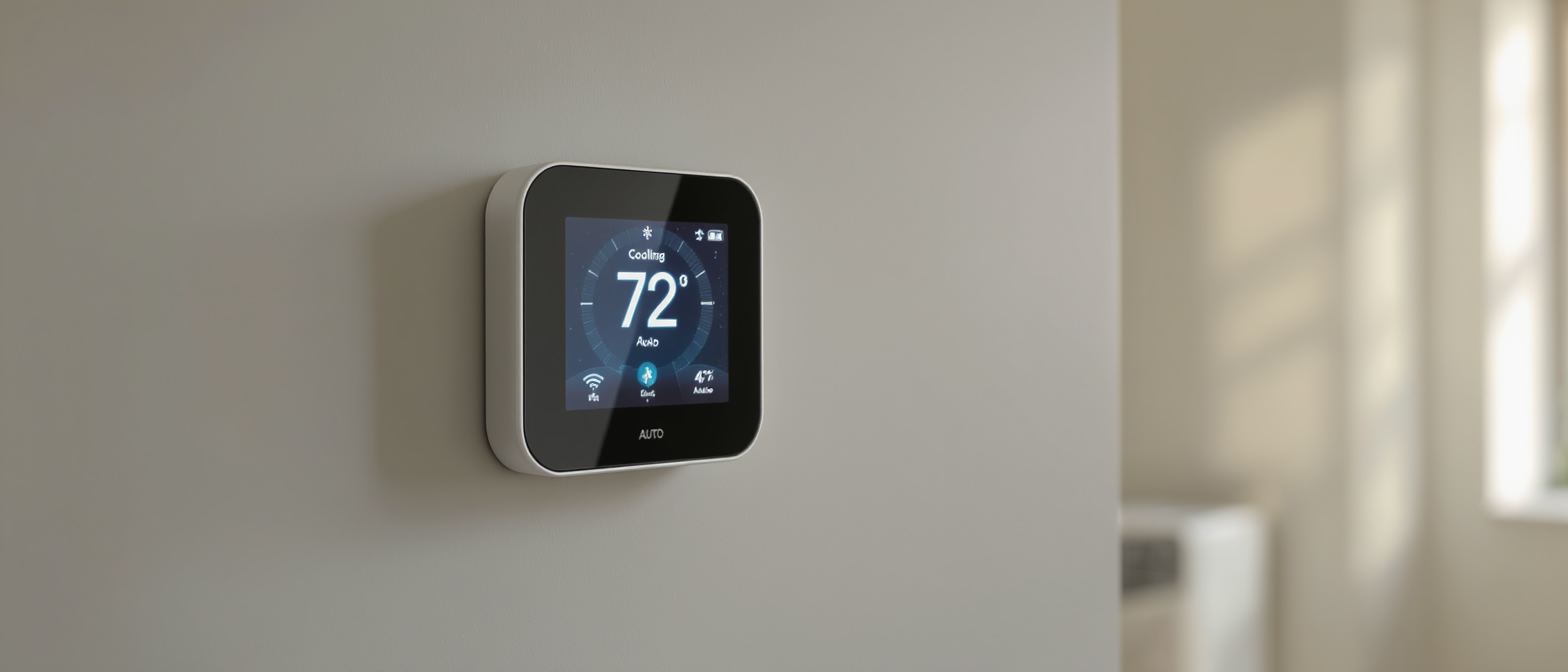What is a smart thermostat and how does it work?

What is a smart thermostat?
A smart thermostat is a connected control for your heating and cooling system that uses sensors, Wi‑Fi, and software to manage temperature automatically. Unlike a basic programmable thermostat that follows a fixed schedule, a smart thermostat learns patterns, adapts to weather and occupancy, and can be controlled from your phone or voice assistant. In homes and businesses, it helps balance comfort, healthy air, and energy costs.
How does a smart thermostat work?
Core components
Sensors: temperature, humidity, motion/occupancy, and sometimes air quality or proximity.
Connectivity: Wi‑Fi for app control, updates, and weather data; some models add Bluetooth or Zigbee.
Control board: interprets signals and energizes calls for heating, cooling, fan, and in heat pumps the reversing valve.
Algorithms: learning preferences, geofencing using your phone’s location, and runtime optimization.
Control loop in practice
The thermostat measures indoor conditions, compares them to your setpoint and schedule, references outdoor weather and utility rate signals when available, then sends low‑voltage calls (Y for cool, W for heat, G for fan, O/B for heat pump reversing) to your HVAC equipment. Some models modulate stages or communicate digitally with compatible systems to fine‑tune output.
Learning and geofencing
Learning algorithms notice when you adjust temperature and shorten recovery time; geofencing sets back when everyone leaves and returns to comfort as you approach home. Together they cut waste while keeping rooms within your comfort band.
Features that matter
Adaptive scheduling that adjusts to weekdays, weekends, and holidays.
Humidity management and dehumidify/overcool features, helpful for comfort and indoor air quality.
Filter and UV lamp reminders based on runtime.
Air quality insights when paired with sensors or compatible equipment.
Alerts for extreme temperatures, potential freezing, or loss of power.
Utility demand response and time‑of‑use awareness where supported.
Voice control and app access for remote changes and monitoring.
Benefits and limits
Smart thermostats can reduce energy use, stabilize comfort, and support healthier indoor air by coordinating ventilation and humidity. However, savings vary by climate and home. In Southern California’s mild seasons, the biggest gains may come from smarter schedules, fan circulation, sealing ducts, and proper equipment sizing—no thermostat can fix poor airflow or insulation by itself.
Compatibility matters. Some systems need a C‑wire to power advanced features; two‑wire heat‑only circuits, multi‑stage equipment, dual‑fuel heat pumps, or zoning panels require careful configuration. Wrong O/B settings can force a heat pump to cool when it should heat. Miswiring can short a transformer or damage a furnace control board. Network security is also important—use strong passwords and updates.
Safety, insurance, and code considerations
Thermostats look simple, but they sit at the center of combustion safety, refrigerant controls, and condensate management. Incorrect dehumidify wiring can flood a drain pan; improper heat staging may cause overheating; defeating safeties is dangerous. Many manufacturers and insurance companies require installation and commissioning by qualified professionals for warranty and coverage. In California, electrical and mechanical codes, permitting, and Title 24 efficiency rules may apply, especially for remodels, add‑on zoning, or commercial controls.
Smart thermostats with mini‑splits and VRF
Ductless and VRF systems often use proprietary communications. The wrong aftermarket thermostat can cripple capacity or void warranties. Gateways made for specific brands translate calls safely. Our engineering team has hands‑on factory training with Fujitsu (Japan), Mitsubishi Elektrik (Thailand), Midea (China), Gree (China), and Hier (China), which helps when integrating smart controls with these systems and planning sequences that protect compressors and manage humidity.
Best practices for setup and use
Confirm equipment type: single‑stage, multi‑stage, heat pump with or without auxiliary heat, zoning, or communicating.
Verify wiring and C‑wire power or use an approved power solution.
Place the thermostat away from direct sun, drafts, supply vents, and electronics that skew readings.
Enable geofencing only if all household members’ phones are included; otherwise rely on schedules plus occupancy.
Update firmware, use strong Wi‑Fi credentials, and review privacy settings.
Set reasonable setbacks (typically 2–4°F) to avoid long recovery times and humidity swings.
Calibrate sensors and check fan circulation to support filtration and fresh air strategies.
When to call a specialist
DIY is fine for simple, compatible systems, but line‑voltage controls, dual‑fuel heat pumps, add‑on dehumidifiers, commercial rooftop units, or multi‑zone panels are not good candidates for trial‑and‑error. In many cases, insurers and manufacturers expect documentation from licensed, manufacturer‑trained technicians. That helps protect your equipment, indoor air quality, and coverage.
Who we are and where we work
#1 AC Guys is a fourth‑generation family team of engineers with 80+ years in engineering, specializing in residential and commercial HVAC, including large and complex projects. Our mission is healthy air at home for a healthy life. We serve Los Angeles County and nearby areas, including Orange County, Ventura County, and Western Riverside County. Cities we frequently work in include Los Angeles, Long Beach, Santa Monica, Pasadena, Glendale, Burbank, Anaheim, Irvine, Costa Mesa, Santa Ana, Ventura, Oxnard, Camarillo, and Corona.
Key takeaway
A smart thermostat is a sensor‑rich, connected controller that learns, adapts, and coordinates HVAC for comfort, efficiency, and healthier air. Selecting the right model, integrating it correctly, and commissioning it to your specific equipment are essential steps—often requiring qualified expertise to stay safe, code‑compliant, and covered by warranty and insurance.
Yasmine is currently an Associate Professor of Psychology at Mount Saint Mary College where she teaches a wide array of courses in the Psychology department. She is a Fulbright Scholar spent a year working at the Medical Decision Making Center at Ono Academic College in Israel.
Yet, as many higher education professionals can surely attest to, I have also witnessed the other challenge in group decision making. In academia, engaging in critical dissent is encouraged (reviewed by Jetten & Hornsey, 2014), and while this is a fine attribute, practically,
